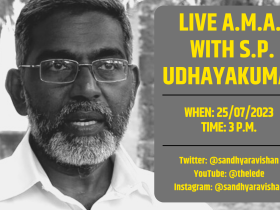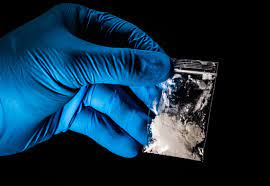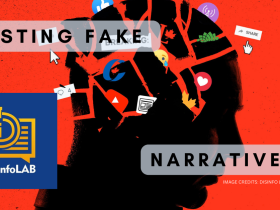In 2016, a group of men undertook a month-long journey from the Americas to Asia.
Mexican nationals Jorge Ayon Peña, two others known as Francisco and Fernando embarked from Culiacán in Sinaloa to Shanghai, Hong Kong, Tokyo, Indore, Rajasthan, back to Tokyo, finally returning to Mexico on 21 February 2016.
Peña had been active on Facebook throughout the trip, posing with his fellow travellers, revelling in the sights of Asia.
In Hong Kong and in India, the trio were joined by Manu Gupta, an Indore-based businessman who was arrested two years later, in 2018, for manufacturing and seeking to smuggle fentanyl illegally to Mexico.
It was not a holiday. It was a business trip.
A classified US Drug Enforcement Administration (DEA) document dated December 2018 that was released as part of Blue Leaks gives a hint as to what the business may have been. “Gupta is an alleged associate of a known Sinaloa Cartel member, who obtains precursor chemicals used to manufacture illicit drugs in Mexico that are subsequently distributed in the United States. The Sinaloa Cartel member traveled to Asia to meet with Gupta and a Chinese national. They were working in tandem with chemical sources in China and India to obtain and/or produce fentanyl,” said the report.
Intelligence sources informed The Lede that all three foreign nationals in these photographs are Sinaloan cartel members.
Asia, especially China, has been the key supplier country of fentanyl precursors to Mexican drug cartels. Precursors are chemicals that go into making fentanyl, a synthetic opioid which is used in legal medicines as a painkiller or anaesthetic.
The main market of the Mexican drug cartels is the United States and Europe. In the US, the drug has claimed thousands of lives. In 2018, fentanyl and similar synthetic drugs accounted for nearly half of the 67,367 drug overdose deaths in the United States. This marks a 10% increase from 2017 – an epidemic equivalent to the heroin crisis from 2000-2010.
A Sinaloan Cartel Chemist Opens Up
South American drug cartels moved to mass production of cocaine from marijuana in the 1970s. Heroin was the next big drug and Mexican drug cartels became powerful in the late 1990s. Of these, the Sinaloan cartel headed by El Chapo was one of the biggest and most violent groups. Methamphetamine came next, a purely synthetic drug. Fentanyl is the latest popular drug on the market.
The drug cartels have weathered many storms. The Mexican Army destroyed poppy crops, vast fields of coca and marijuana were destroyed in a number of interventions over the years.
“Due to government restrictions, we began the transition to synthetic opiates, which were cheaper,” a chemist hired by the Sinaloa cartel told Forbidden Stories.
Northern Mexico, known as the “golden triangle” because of its marijuana and opioid cultivation, is transforming under the influence of the Sinaloa cartel. In the mountainous terrain around Culiacán, poppy fields are being replaced by laboratories.
The future for drug cartels is synthetic.
In his clandestine laboratory nestled among the trees near Culiacán, the chemist decrypted the business. “It’s one of the most attractive drugs for cartels. It brings in more profits. You only need one pill per person. So if we transport 10,000 pills, then it’s 10,000 people who are going to take them,” continued the chemist.
In a kitchen dish, he stirred white powder with a plastic spatula. This powder is used to make fentanyl pills. Stamped with the letter “M,” these pills are supposed to imitate oxycodone – a highly addictive opioid.
“I know my pill is very powerful and that it will create a dependence,” the chemist said. “And that’s what I want. When a consumer takes one and then needs another dose.”
The lure of fentanyl is its profitability. In a 2019 report, the DEA estimated that a fentanyl pill costs only $1 to produce. Each pill is then resold in the US for $10 or more.
Manufacturing this powerful drug requires only a minimal workforce and infrastructure, and Sinaloa is leading the charge.
“Although it would be difficult to assess the cost to produce a single pill, traffickers can typically purchase a kilogram of fentanyl powder for a few thousand dollars from a Chinese supplier, transform it into hundreds of thousands of pills, and sell the counterfeit pills for millions of dollars in profit,” said US DEA spokesperson Michael Miller to Forbidden Stories, in response to questions from the collaboration.
“If a particular batch has two milligrams of fentanyl per pill, approximately 500,000 counterfeit pills can be manufactured from one kilogram of pure fentanyl. According to DEA reporting, counterfeit pills containing fentanyl or fentanyl-related compounds retail at prices between $5 and $20 per pill in US illicit drug markets (depending on the purity of the fentanyl and the dosage),” he said.
A classified DEA report from October 2019 published in Blue Leaks summarises the situation:
“Law enforcement data analyzed from 2018 through the end of February 2019 indicates that the Sinaloa Cartel has established itself as a prominent producer and trafficker of Mexico-based fentanyl into the United States.”
Despite the arrest in 2016 of Joaquin Guzman, the infamous Sinaloan cartel leader known as El Chapo, the DEA acknowledged that the drug business is still running at full capacity.
Peña And Companies
Exhaustive OSINT investigations done by The Cartel Project collaboration revealed that Peña works as an auditor for Corporativo Escomexa, a Mexican import-export company that specialises in the trade of tequila, and agricultural and chemical products. The company also advertises methamphetamine on various websites online.
The firm also has, as a member of its supervisory council, one Jorge Eduardo Sandoval Rincón.
In December 2015, an article in the Tokyo Reporter detailed the arrest of an Eduardo Jorge Sandoval Rincón by Japanese authorities. The man, described as a 42-year-old Mexican national, was apprehended for smuggling “stimulant drugs” into Japan from Mexico. The drugs were hidden in bottles of tequila. The collaboration was unable to confirm whether these two men are the same person, or whether they simply share a name. All attempts to reach Sandoval Rincón were unsuccessful.
An analysis of Corporativo Escomexa’s trades revealed multiple suspect transactions from September to October 2016. Over the course of one month, the company received a collection of pharmaceutical equipment from India – notably a pill press machine. They also obtained 676 kg of lactose monohydrate powder, microcrystalline cellulose, and copovidone, all of which are used to make narcotic substances, including fentanyl.
Although Corporativo Escomexa’s most recent activities on the platform Panjiva were recorded in October 2016, the collaboration was able to identify a large network of businesses still active today that are connected to the Mexican company in various capacities.
“This network appears to be quite extensive and may include dozens of companies operating in both Mexico and the United States. Some of these companies also only have trade data for short periods of time before a new or different company within the network picks up primary shipping responsibility,” wrote C4ADS, a non-profit that analyses data, in a report for the collaboration.
One such company, Corporativo y Enlace Ram, appears to share an address, an agent, and import similar pharmaceutical products. The two companies share suppliers as well. According to available online data Enlace Ram received a shipment in June 2016 from Mondiale Mercantile – the company owned by Manu Gupta. In addition, there are pictures of the people in charge of Enlace Ram next to Peña.
A perusal of the site Panjiva, which tracks global movements of goods, shows that Manu Gupta’s firm Mondiale Mercantile has been active in the export of chemicals to China and Mexico.
“Mondiale Mercantile’s most shipped items as listed on shipping data displayed on Panjiva are benzyl chloride and benzyl alcohol. Benzyl chloride is a DEA Schedule II regulated chemical in the United States18 and is a known chemical precursor to methamphetamine. On 30 December 2014, Mondiale Mercantile shipped 8.8 tons of benzaldehyde to Petra Procesadora de Piedras, SA de CV. Petra Procesadora de Piedras is one of Jorge Renan Solis Fernandez’s multiple companies located in Guadalajara, Jalisco. The table below also shows that Mondiale Mercantile shipped 5,400 kg of thioglycolic acid to Mexican entity Corporativo y Enlace Ram, SA de CV.20 Corporativo y Enlace Ram is linked to Corporativo Escomexa by mutual employees,” observes the C4ADS report.
Petra Procesadora de Piedras belongs to Jorge Renan Solis-Fernandez, who is currently lodged in Indore District jail along with Manu Gupta for attempting to smuggle fentanyl out of India to Mexico. Corporativo y Enlace Ram and Corporativo Escomexa are both companies linked to Jorge Ayon Peña.
“While no overt indications of criminal activity were uncovered, the existence of import-export ties and domestic commercial relationships maintained by Corporativo Escomexa SA de CV and its linked entities may warrant further inquiry or offer indications of the modus operandi of trans-Pacific fentanyl or methamphetamine trafficking networks,” wrote C4ADS.
When asked for a response on this, Jose R, one of the two managers of Corporativo y Enlace Ram, told the collaboration that he did not know Peña, Escomexa or “this Indian supplier” Manu Gupta.
Peña did not respond to requests for an interview.
Indian intelligence sources told The Lede that Peña was under investigation by US authorities.
There is no clarity, however, on whether the arrested Mexican national, Jorge Renan Solis-Fernandez is a member of the Sinaloan cartel or whether he was an independent player who was carrying out instructions.
“That’s one of the main myths – the popular image of a cartel as this perfectly integrated organisation,” Falko Ernst, researcher at International Crisis Group in Mexico told Forbidden Stories.
Outsourcing to independent networks that specialise in logistics or money laundering is a common practice for cartels, including Sinaloa, he said.
“They’re the actual sort of backbone of this whole business,” Ernst explained. “Cartels’ brand names fade away eventually. All of those networks stay in place because they’re much less visible. They’re much more clandestine in their operations. They don’t go public and they’re much more shielded from this sort of thing in short term/medium term overhauls and volatility of the market,” he explained.
Enter India As Supplier Country
Until very recently, China produced the majority of fentanyl sold in the US.
“You had individuals importing fentanyl from China, pressing the tablets in their basement and then putting those online for retail, on the darknet, or connecting up with a local distributor to sell those on the street,” explained Bryce Pardo, an associate researcher at RAND and an expert on the synthetic drug market, in an interview to Forbidden Stories.
But stricter regulations imposed internationally and in China, in 2017 and 2019, changed the game. There was a need to identify and set up new supply routes for precursor chemicals so the drug trade could go on.
A document by the US Drug Enforcement Administration which was made public as part of the Blue Leaks throws light on which country the cartels are looking at next, after China.
“India may already be supplementing China’s illicit fentanyl production and is poised to replace it in the future. With China restricting fentanyl and fentanyl precursors, TCOs (Transnational Criminal Organisations) will look for alternatives in other regions with fentanyl manufacturing capabilities and little regulatory oversight, such as India. In 2017, the RWR Advisory Group conducted research of online fentanyl sales and published an article which reported that 5.6 percent of the fentanyl product listed for sale online was exported from India.
India is known for their ability to manufacture a wide variety of chemicals and generic pharmaceutical drugs, as well as having a surplus of knowledgeable chemists. Indian chemists have the knowledge and expertise to manufacture fentanyl without the precursor chemicals NPP and 4-ANPP, which will increase the difficulty of detection and oversight within India,” stated the report.
Mexican Cartels And Their Known Networks In India
The Lede is informed that Indian law enforcement agencies are working together with the US DEA to crack down on the network that Mexican cartels have begun to form in India to supply them with fentanyl precursors.
“While I can’t speak to the specifics of investigations, I can say in the last half of 2018, DEA in conjunction with our counterparts in India, conducted two separate operations that seized approximately 100 kilograms of suspected fentanyl or fentanyl precursors and 11 kilograms of fentanyl connected to an illicit fentanyl laboratory. Both of these seizures were destined for Mexican TCOs and indicate that Indian chemists have the knowledge and expertise to manufacture fentanyl without NPP and 4-ANPP, which will increase the difficulty of detection and oversight within India,” said US DEA spokesperson Michael Miller.
Apart from the Indore bust, in 2018, Mumbai’s Anti Narcotics Cell (ANC) seized a consignment of around 100 kilograms of illegally procured NPP, a fentanyl precursor) in a car in Vile Parle. Four people were arrested near the service road outside the Mumbai Airport. One of the accused, according to sources, was part of the late underworld don Iqbal Mirchi’s gang.
The key accused Salim Dola had been planning on exporting the chemical by air to Mexico under the name “Organis sacha inchi powder” to a company called Vesuvius Mexico. Vesuvius had been created from forged documents by a company named Ortec International Trading House. Dola had earlier been arrested in the early 1990s for selling a popular drug at the time, metaclonon.
Further investigations in this case led to arrests of a number of persons exporting fentanyl precursors illegally to Mexico. Raids were conducted on several chemical manufacturing units in Ahmedabad, Rajkot and Rajasthan, according to highly placed sources in the Narcotics Control Bureau.
Mumbai ANC officials informed The Lede that investigations are ongoing and they expect to make more arrests soon.
Monitoring Precursor Sales
In its latest report on precursor trade, the International Narcotics Control Board, a UN body that monitors compliance with international drug treaties, flagged how legitimate and illegitimate exporters and importers form part of the global network that aid the Mexican cartels.
“INCB has become aware of exports in 2018 of NPP from India that lacked the required no-objection certificates, i.e., that were effected without the knowledge of the competent national authorities, even though NPP and ANPP have been under national control in India since February 28, 2018. Although the authorities in India made an arrest and are investigating the incidents, which allegedly involved the same modus operandi, INCB has determined that, in at least one instance involving 400 kg of the substance, the consignee in Europe was legitimate and authorized to import NPP and ANPP,” stated the report.
So how serious is the problem?
“In late 2018, India emerged as a source country for fentanyl and fentanyl precursors trafficked by Mexican Transnational Criminal Organizations (TCOs),” said US DEA Spokesperson Michael Miller.
India may assist with offsetting the regulations in China. Reporting indicates Mexican TCOs are expanding their sources of supply, but China remains the primary source country.”
“As of now, it is under control,” a senior officer in the Narcotics Control Bureau, Delhi told The Lede. “But law enforcement agencies have to keep a close watch. It is true that Mexican drug cartels are looking at India as the next supply source of fentanyl precursors. The problem is that these same chemicals are used for legal manufacture of medicines as well, so identifying what is going to the illegal drug trade is difficult. We have to be vigilant and ensure that we nip these activities in the bud. We are watching closely,” he said.
(With additional reporting by François Ruchti (RTS), Michael Standaert (South China Morning Post), Audrey Travère (Forbidden Stories) and C4ADS.)












Leave a Reply